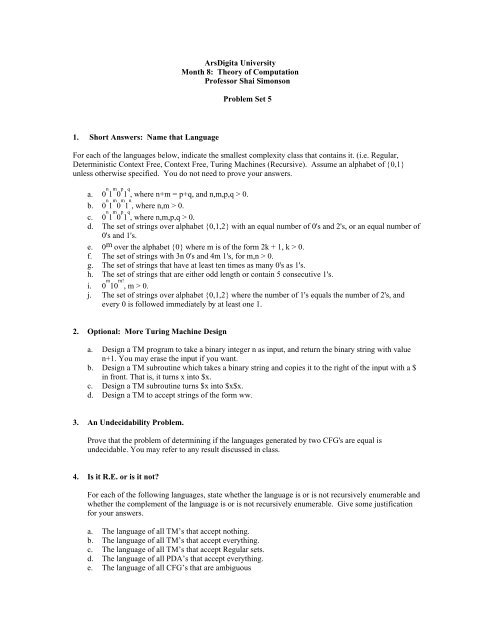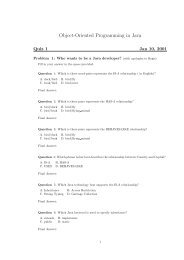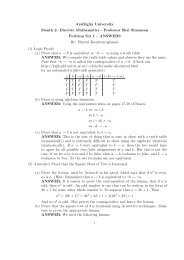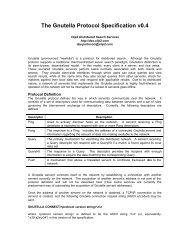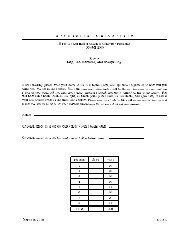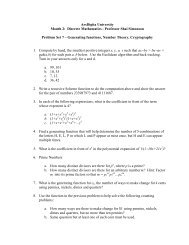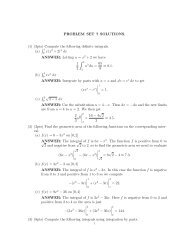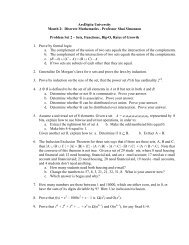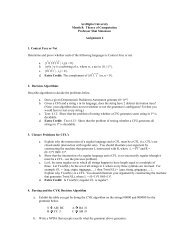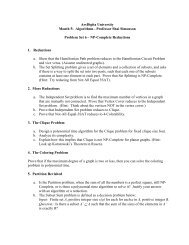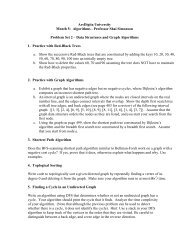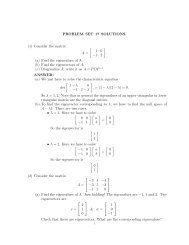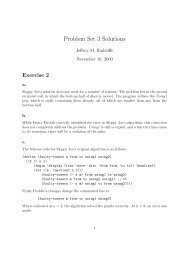Theory of Computation Professor Shai Simonson Problem Set 5 1.
Theory of Computation Professor Shai Simonson Problem Set 5 1.
Theory of Computation Professor Shai Simonson Problem Set 5 1.
You also want an ePaper? Increase the reach of your titles
YUMPU automatically turns print PDFs into web optimized ePapers that Google loves.
ArsDigita University<br />
Month 8: <strong>Theory</strong> <strong>of</strong> <strong>Computation</strong><br />
Pr<strong>of</strong>essor <strong>Shai</strong> <strong>Simonson</strong><br />
<strong>Problem</strong> <strong>Set</strong> 5<br />
<strong>1.</strong> Short Answers: Name that Language<br />
For each <strong>of</strong> the languages below, indicate the smallest complexity class that contains it. (i.e. Regular,<br />
Deterministic Context Free, Context Free, Turing Machines (Recursive). Assume an alphabet <strong>of</strong> {0,1}<br />
unless otherwise specified. You do not need to prove your answers.<br />
a. 0 n 1 m 0 p 1 q , where n+m = p+q, and n,m,p,q > 0.<br />
b. 0 n 1 m 0 m 1 n , where n,m > 0.<br />
c. 0 n 1 m 0 p 1 q , where n,m,p,q > 0.<br />
d. The set <strong>of</strong> strings over alphabet {0,1,2} with an equal number <strong>of</strong> 0's and 2's, or an equal number <strong>of</strong><br />
0's and 1's.<br />
e. 0 m over the alphabet {0} where m is <strong>of</strong> the form 2k + 1, k > 0.<br />
f. The set <strong>of</strong> strings with 3n 0's and 4m 1's, for m,n > 0.<br />
g. The set <strong>of</strong> strings that have at least ten times as many 0's as 1's.<br />
h. The set <strong>of</strong> strings that are either odd length or contain 5 consecutive 1's.<br />
i. 0 m 10 m! , m > 0.<br />
j. The set <strong>of</strong> strings over alphabet {0,1,2} where the number <strong>of</strong> 1's equals the number <strong>of</strong> 2's, and<br />
every 0 is followed immediately by at least one <strong>1.</strong><br />
2. Optional: More Turing Machine Design<br />
a. Design a TM program to take a binary integer n as input, and return the binary string with value<br />
n+<strong>1.</strong> You may erase the input if you want.<br />
b. Design a TM subroutine which takes a binary string and copies it to the right <strong>of</strong> the input with a $<br />
in front. That is, it turns x into $x.<br />
c. Design a TM subroutine turns $x into $x$x.<br />
d. Design a TM to accept strings <strong>of</strong> the form ww.<br />
3. An Undecidability <strong>Problem</strong>.<br />
Prove that the problem <strong>of</strong> determining if the languages generated by two CFG's are equal is<br />
undecidable. You may refer to any result discussed in class.<br />
4. Is it R.E. or is it not<br />
For each <strong>of</strong> the following languages, state whether the language is or is not recursively enumerable and<br />
whether the complement <strong>of</strong> the language is or is not recursively enumerable. Give some justification<br />
for your answers.<br />
a. The language <strong>of</strong> all TM’s that accept nothing.<br />
b. The language <strong>of</strong> all TM’s that accept everything.<br />
c. The language <strong>of</strong> all TM’s that accept Regular sets.<br />
d. The language <strong>of</strong> all PDA’s that accept everything.<br />
e. The language <strong>of</strong> all CFG’s that are ambiguous
5. A Refutation <strong>of</strong> the Halting <strong>Problem</strong><br />
Consider the language <strong>of</strong> all TM’s that given no input eventually write a non-blank symbol on their<br />
tapes. Explain why this set is decidable. Why does this not contradict the halting problem<br />
6. The Post Correspondence <strong>Problem</strong> for One-Character Strings.<br />
Prove that the PCP problem is decidable for strings over the alphabet {0}.<br />
7. Extra Credit: Even Oracles Sometimes Need Oracles.<br />
(Text: 6.22) Let<br />
Z = { | M is an oracle TM and M ATM accepts w}.<br />
Use a pro<strong>of</strong> by diagonalization to show that an oracle TM with an oracle for A TM can’t decide Z.<br />
8. Extra Credit: Variations on the theme <strong>of</strong> 3SAT.<br />
a. Prove that the 3SAT variation where each variable x and –x appear in exactly two clauses is still<br />
NP-Complete.<br />
b. Prove that the 3SAT variation where each variable x an –x appear in exactly one clause is solvable<br />
in polynomial time. (Hint: Think <strong>of</strong> the polynomial algorithm for 2SAT).<br />
9. Satisfiability for DNF Formulas is in P.<br />
Prove that the problem <strong>of</strong> determining whether there is a T/F assignment that makes a given disjunctive<br />
normal formula true can be solved in polynomial time. How do you explain this in light <strong>of</strong> the fact that<br />
any formula in conjunctive normal form can be converted to one in disjunctive normal form, and the<br />
satisfiablity <strong>of</strong> CNF formulas is NP-Complete<br />
10. A Punchcard Puzzle that is NP Complete.<br />
(Text: 7.26). You are given a box and a collection <strong>of</strong> cards. Because <strong>of</strong> the pegs in the box and notches<br />
on the cards, each card will fit in the box <strong>of</strong> either two ways. Each card contains two columns <strong>of</strong> holes,<br />
some <strong>of</strong> which may not be punched out. The cards can be flipped about the vertical axis so that the<br />
columns are interchanged. The puzzle is solved by placing all the cards in the box so as to completely<br />
cover the bottom <strong>of</strong> the box, (i.e., every hole position is blocked by at least one card that has no hole<br />
there.) Let<br />
PUZZLE = { | each c i represents a card and this collection <strong>of</strong> cards has a solution. }<br />
Show PUZZLE is NP-complete. (See the text for an illustration <strong>of</strong> the cards.)<br />
1<strong>1.</strong> PSPACE Hard implies NP Hard<br />
(Text: 8.6). Show that any PSPACE-hard language is also NP-hard.
12. A TIC-TAC-TOE-Like Game that is in PSPACE<br />
(Text: 8.10). The Japanese game go-moku is played by two players, “X” and “O”, on a 19x19 grid.<br />
Players take turns placing markers, and the first player to achieve 5 <strong>of</strong> his markers consecutively in a<br />
row, column, or diagonal, is the winner. Consider this game generalized to an n by n board. Let<br />
GM = { | P is a position in generalized go-moku,<br />
where player “X” has a winning strategy}<br />
A position means a board with markers on it , such as may occur in the middle <strong>of</strong> a play <strong>of</strong> the game.<br />
Show that GM is in PSPACE.<br />
13. A Punchcard Puzzle that is PSPACE Complete.<br />
(Text: 8.14). Consider the following two-person variation <strong>of</strong> the language PUZZLE that is described in<br />
problem d. above. Each player starts with an ordered stack <strong>of</strong> puzzle cards. They take turns placing<br />
them in order in the box and may choose which side faces up. Player I wins if, in the final stack, all<br />
hole positions are blocked, and Player II wins if some hole position remains unblocked. Show that the<br />
problem <strong>of</strong> determining which player has a winning strategy for a given starting configuration <strong>of</strong> the<br />
cards is PSPACE-complete.<br />
14. Extra Credit: Regular Expression Equivalence is in PSPACE<br />
(Text: 8.16). Let EQ REX = {| R and S are equivalent regular expressions}. Show that EQ REX is in<br />
PSPACE.<br />
15. Extra Credit: Kleene Star Preserves P<br />
(Text: 7.13). Show that P is closed under the Kleene star operation. (Hint: on input y = y 1 …y n for yi in<br />
Sigma, build a table indicating for each i
17. Extra Credit: Two Counters Are All You Really Need In Life<br />
Prove that two counters are enough to simulate a Turing Machine. (Hint: prove that two counters can<br />
simulate a stack, then prove that two counters can simulate four counters).<br />
18. Extra Credit: Infinite Recursive <strong>Set</strong>s Hiding In R.E. <strong>Set</strong>s<br />
Show that every infinite recursively enumerable set has an infinite recursive subset. (Hint: Prove that a<br />
TM exists that generates the r.e. set. That is, it starts with an empty tape and keeps printing strings in<br />
the set. Consider the set <strong>of</strong> all strings x which are among the first 2^|x| strings generated by this TM.<br />
Prove that this set is infinite and recursive.)


